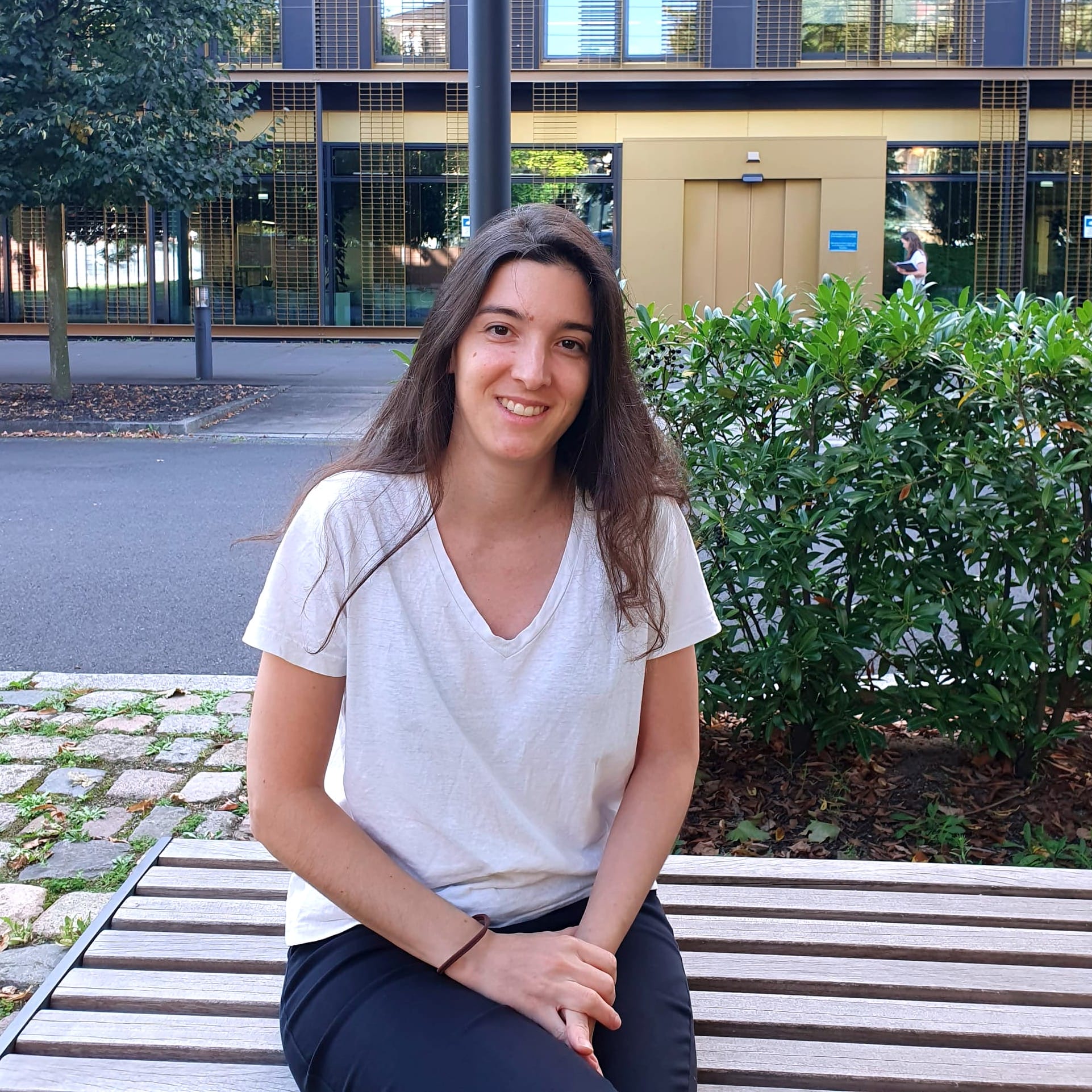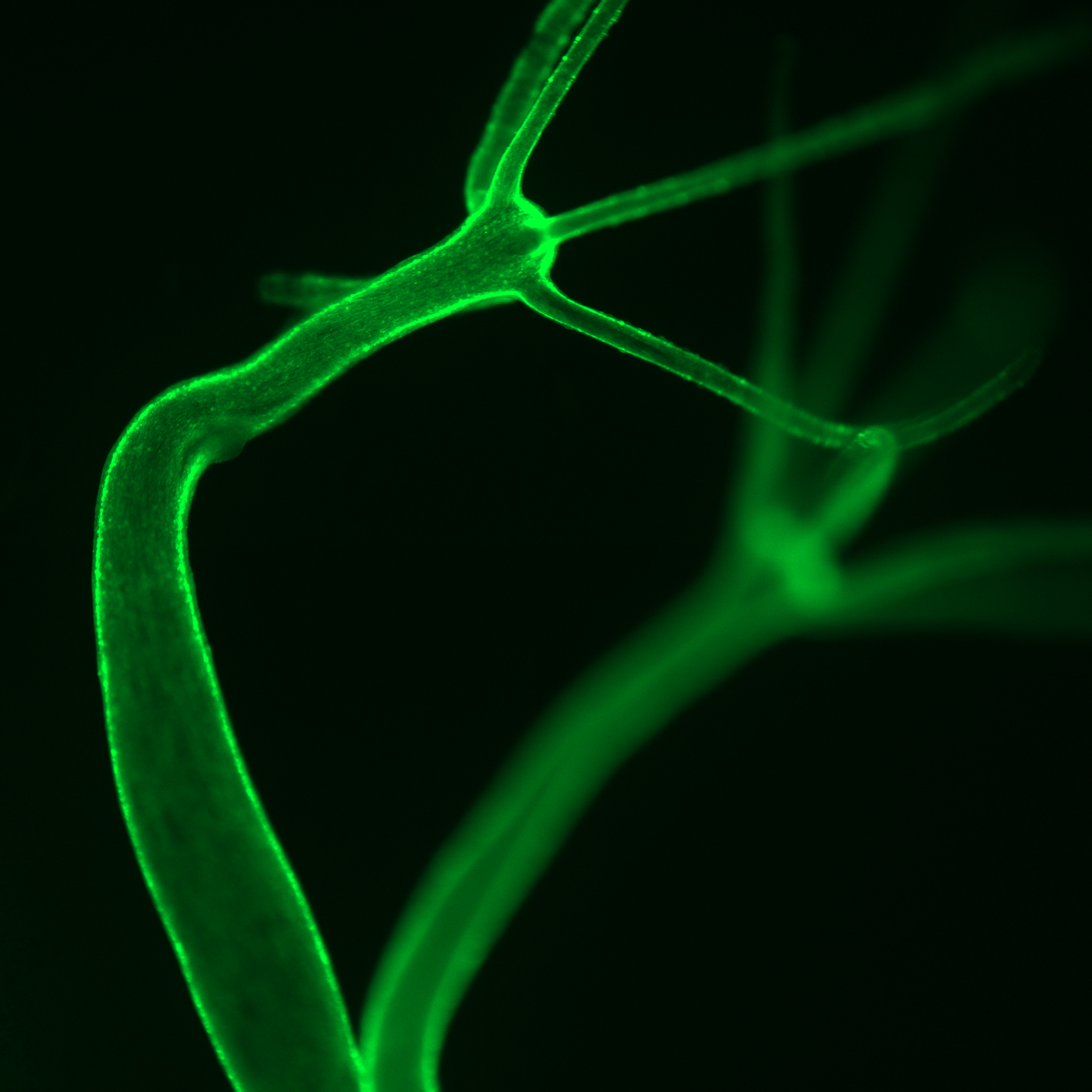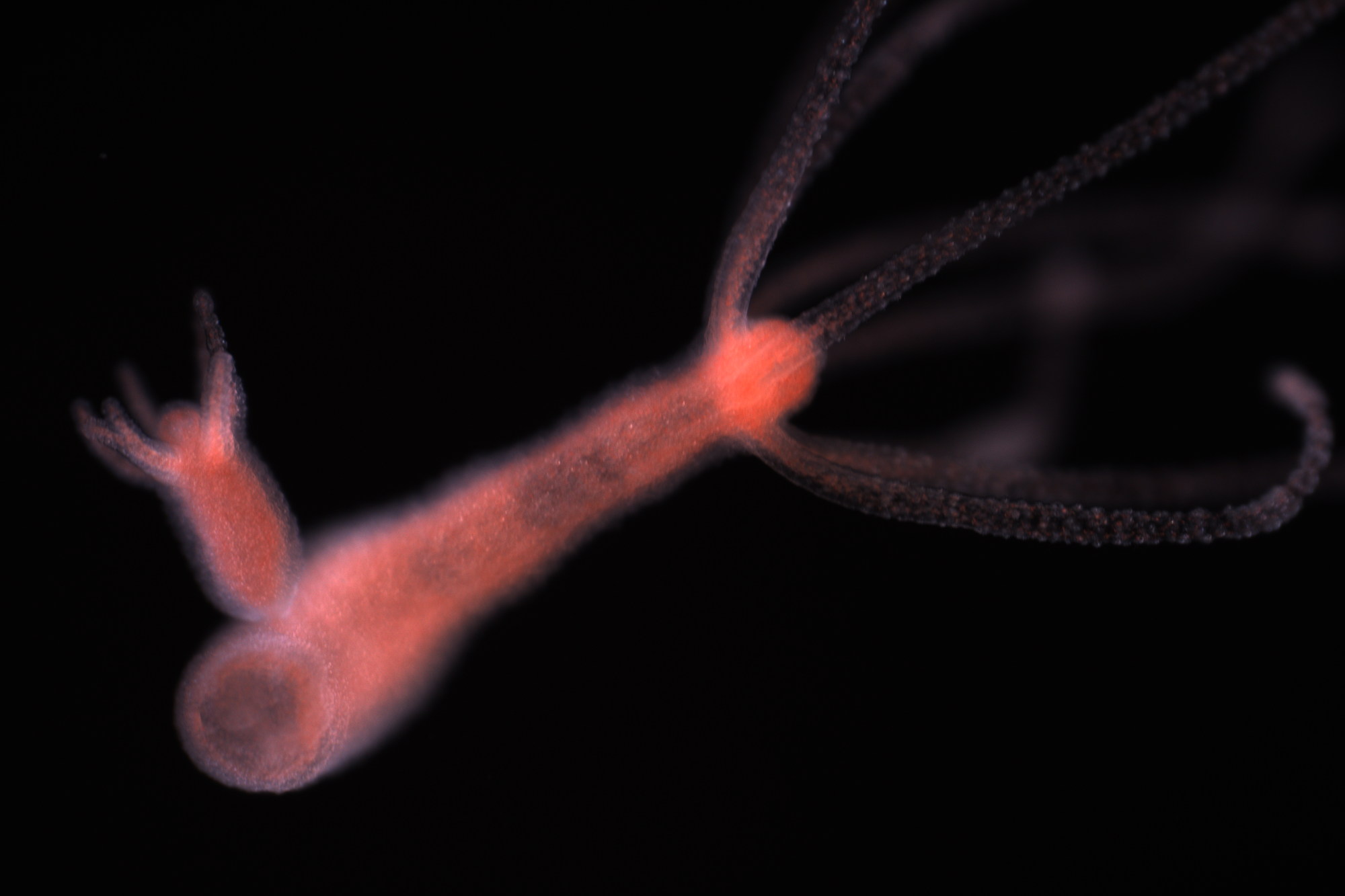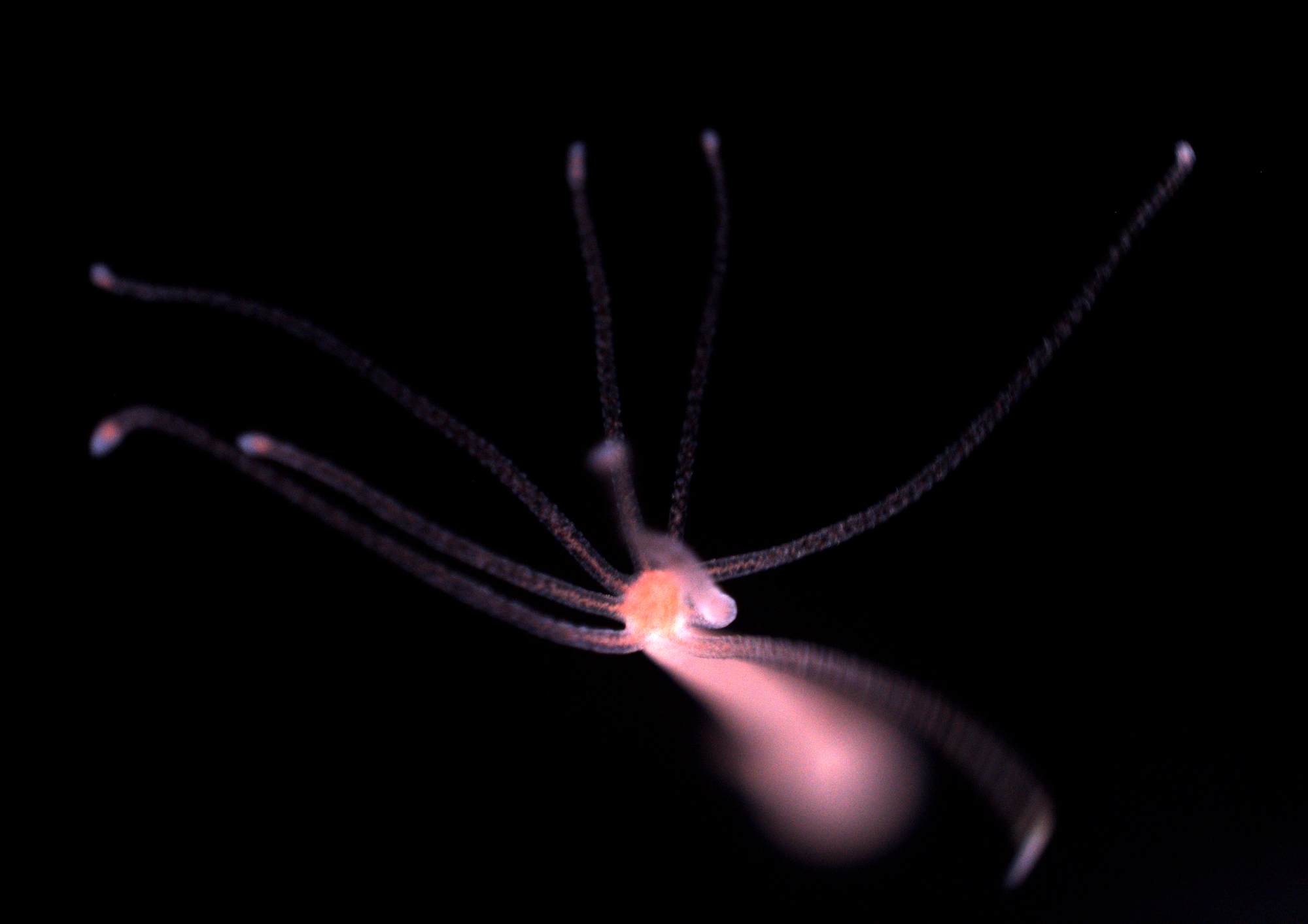Hydra are a cosmos in a cuvette
To see order emerge from chaos, Anaïs Bailles shreds up immortal animals and watches them re-grow

The early universe was orderly, but formless. With everything the same everywhere, nothing could happen. But quantum fluctuations near the beginning of time infused the neat and tidy early universe with a pinch of disorder — a bit more energy here, a bit less there. And when the universe expanded, those little patches of slightly denser or sparser stuff grew with it. Today, they're smeared across the sky, visible as miniscule fluctuations in the temperature of the Big Bang's radio afterglow. Everything else — the galaxies and stars and planets of the observable universe — grew up from those first seeds of chaos.
Anaïs Bailles, a physicist-turned-biologist at the Max Planck Institute of Molecular Cell Biology and Genetics in Dresden, Germany, sees a mirror of this cosmic origin story in the animal embryo. Beginning from a relatively shapeless, simple state, animals develop into structured, complex forms. This poses a question similar to the one faced by cosmologists: where does all that new complexity come from? Anaïs thinks that her old field, physics, might have answers for her new one.

Biologists tend to look for explanations in either nature or nurture, and the enormous success of genetics has effectively collapsed "nature" down to the genome. Nature is what's "written in our DNA," in the "blueprint of life." But there are limits to this reductive understanding of how organisms come to be, and the blueprint turns out to be a pretty terrible metaphor for the genome; nowhere in your genes will you find the schematics for an eye. What you will find are instructions for a collection of parts that, embedded in the right environment, will interact with each other to produce more-or-less the same organism, more-or-less every time — but not exactly the same organism, and not every time. If the full story of life is not written in DNA, we must be missing more than several chapters.
Scientists studying development are re-discovering some of the lost pages by reviving an old perspective: life as mechanics. More than a century ago, D'Arcy Thompson pointed out that the geometry of biology can often be explained by the constraints that physics and geometry place on growing organisms.[1] In Thompson's view, survival of the fittest might explain why the nautilus has its shell, but not its logarithmic spiral — the latter reflects mathematical constraint, not evolutionary advantage. Thompson's mathematical biology was largely eclipsed by genetics in the early 20th century, and for good reason. Genetics worked. But it was not the whole story, as our ongoing struggle to effectively treat or even explain any disease that isn't caused by a single-gene mutation or obvious pathogen makes painfully clear. This is especially true when it comes to the brain; most mental illnesses and developmental disorders are clearly genetic to some degree, but not entirely.[2] Even autism, which is highly genetic, is not entirely genetic. Identical twins are different enough that one can be autistic while the other is not, despite sharing a genome.[3]
Your genome is not a blueprint. A thread about misleading metaphors in science communication. 🧬🧪 1/n
— Simon Fisher (@profsimonfisher.bsky.social) June 14, 2025 at 5:50 PM
[image or embed]
Anaïs studies how physical forces, random chance, and geometric constraint sculpt life's endless forms most beautiful by watching animals assemble themselves cell for cell. In particular, she is interested in how animals manage to organize themselves starting from random, disorganized starting conditions — might chance have a hand in shaping life, as it does in the cosmos?
To tackle that big question, she's studying a tiny animal. The microscopic freshwater polyp Hydra vulgaris, a relative of jellyfish, has a simple, linear body plan with a foot on one end, tube-like torso, and a head surrounded by stinging tentacles used to grab prey. And like its mythological namesake, Hydra can't really be killed by slicing and dicing. Cut off a chunk of a Hydra, and it'll grow into an entirely new animal. For Anaïs, the remarkable regeneration abilities of Hydra make it the perfect animal to study how life finds order in chaos. That's because Hydra doesn't just regrow from chunks — you can completely randomly reshuffle its cells into a blob and it'll regrow, no problem. And if that's not crazy enough, you can shred up dozens of Hydra, throw their cells in a blob, and even that blob will regrow... albeit with a few extra heads.
To regrow, a glob of hydra cells needs to figure out where the head's going to go. This seems to involve filaments of a protein called actin, which run up and down the hydra's tube-like body from head to foot. In a chaotic aggregate, cells start out with their actin fibers pointing every which way. But, somehow, they "decide" on a direction and all line up, like compass needles in a magnetic field.
In a recent paper published in PNAS, Anaïs and her colleagues showed that physical forces — not chemical signals, as previously thought — might explain how Hydra pick a spot for their head. In a nutshell, they define a body axis based on how their cells are being stretched. I spoke with Anaïs about the new study, the links between physics and biology, the wonderful weirdness of Hydra, and the power of watching life like an astrophysicist watches the sky. The interview has been edited and condensed for clarity.

You're a physicist by training. How did you end up studying hydra?
When I started physics, I was actually very interested in cosmology and astrophysics. And I think there are similar questions in cosmology and biology, for instance: why is there something at all in the universe instead of nothing? It's precisely this question in developmental biology of how have you can have the emergence of shapes from something that is completely unformed. So I think it's kind of linked. But I discovered biology when I did one year of history of science at university and stopped physics for a while. One day, I saw a picture of a zebrafish developing where you can see all the nuclei, and it really looks like a bit like stars in the sky. And I thought: okay, that's what I want to study now, the development of embryos.
So emergence—especially how shapes come to be—was the bridge between cosmology and biology for you?
Yes. There are vast questions that I doubt I will never be able to answer, like how complex shapes emerge and how huge collective of cells organize to make something like a human or other species. There are billions of cells in a given organism, and they manage to work together. This is what I'm trying to understand, how they do that. If we can talk about astrophysics again, there are more cells in your body than stars in the in the Milky Way. So that's a very complex thing in itself.
There's this little ball of cells made of like 50 different hydras. And they don't care, they will actually make just one individual out of that.
Those are some big questions. Why study Hydra, specifically, to answer them?
It's a really good example of a purely self-organized system.
Before Hydra, I was studying Drosophila (the fruit fly), which is a very important model in developmental biology. But Drosophila is very pre-patterned. Eggs start out with a lot of signals that were put there by the mother. She'll put in some RNA that says, 'okay: here will be the head,' and on the other side some RNA that says say, 'okay: here will be the tail.' For other species, pre-patterning can come from the position of sperm entry, which creates one of the axes of the body. In these cases, the cell is already ready-made with a coordinate system. They have a large part of this information loaded in advance.
I wanted a purely self-organized system where the cells have no pre-existing pattern or direction, and really need to communicate with each other to organize themselves. And that's something that Hydra can do: you can dissociate the cells of a Hydra and put them together, and the information about what they have to do and where they were in the initial body plan of the organism is thoroughly mixed and randomized. And yet they manage to communicate with each other and build a full animal again.
A ball of randomly mixed-together Hydra cells drawn from several individuals re-generates into a new individual with several heads. Credit: A. Bailles, G. Serafini, H. Andreas, C. Zechner, C.D. Modes, & P. Tomancak, Anisotropic stretch biases the self-organization of actin fibers in multicellular Hydra aggregates, PNAS. (2025).
So let me see if I understood this: you can kind of take apart a Hydra, take all the cells, scramble them up — maybe even take cells from different organisms — put them together, and then they'll grow a new hydra. Is that right?
Yes, exactly. And it's pretty like low tech: you take them apart with a pipette, it's just shearing them until you've destroyed every shape. You just have cells. Indeed, most of the time I mix like 50 hydras together. And they don't care, they will actually make just one individual out of that.
Why bother mixing up hydra to make these chaotic aggregates? Why not just study their normal development?
It's random. It's completely mixed, so they have to start organizing from this very chaotic population without any pre-pattern to guide development.
In this study, you focused on protein fibers called actin. Why?
Actin is a very, very important polymer for the mechanical property of cells. In Hydra, these fibers align along the body axis. So there's kind of a little compass in each cell that points towards the head. If you look at the actin fibers, you can tell where each cell thinks the future head is going to be. Initially, they the actin fibers point in random directions and progressively they align — they're kind of deciding together where the head and the body axis will be.
Cells can communicate by sending chemical signals — by sending molecules to each other — and that's one way of communication. But they can also exchange forces.

This might be a bit of a stretch, but the alignment of these actin fibers during development sounds a lot like the alignment of magnetic spins in an Ising model.
Yeah, yes. You can think of it like a spin glass in that you have something that aligns itself in a purely passive way.
You borrowed physics from a different physical system in this study—liquid crystals. So, how are actin fibers like liquid crystals?
We make an analogy to liquid crystals, which are elongated molecules. They're rod shaped, but embedded in a fluid, so the molecule can both flow and interact with other molecules. It's just what we call steric interaction — it's just about the fact that they can't cross each other. So if you have two pushing on each other, they'll kind of align. You can imagine taking a matchbox and shaking it. The matchsticks will align. Just because of their shape, they will pack better if they align. That's the idea of a nematic liquid crystal, which just refers to the orientation of the rods. It's kind of a first step to treat Hydra as some inert passive system — but of course it is not, because each of these cells is actually able to consume energy and act. I think in the future, I will try to see how the system's behavior diverges from that of a truly passive one.
What did you hope to find out about development by studying cells in through this very physical lens?
The motivating question for me was to see the impact mechanics has in the self-organization process. Cells can communicate by sending chemical signals — by sending molecules to each other — and that's one way of communication. But they can also exchange forces. Coming from biophysics and physics, that's what interests me: seeing how two cells can talk to each other, but with forces.
That's the general question. In this case, what we tried to understand is how ordering can be helped by mechanics. This is where the nematic liquid crystal analogy comes in — we don't say the aggregates are a liquid crystal, but they behave like one. So the physical tools help us describe what is going on. The two things we brought together are live imaging with light sheet microscopy, which is a specialty of my current lab, and looking at the dynamics of how the self-organization happens using actin as a proxy for mechanical forces and properties.
I think we learn a lot just by watching what's going on. That's how people use to do it at the beginning in biology. And it's what you do in astrophysics, actually. You just watch.
How important was the microscopy for this study? The images are beautiful, but were they key parts of the science?
The live imaging was super important. I really like to just watch the development of embryos or, in this case, balls of cells. I think we learn a lot just by watching what's going on. That's how people use to do it at the beginning in biology. And it's what you do in astrophysics, actually. You just watch. So some of it was really just that: sitting down and looking at this and trying to understand by just watching. Then there was the physical analysis using the nematic liquid crystal analogy. I wrote a little program to look at the average orientation of cells and represent it as a nematic angle. Then we could make movies where you can see the nematic phases and extract something from it, called an order parameter. So we have this one number which tells you how ordered the cells are locally—how the little compasses align locally and evolve with time.
What did your analysis reveal about how order coalesced out of chaos in these aggregates?
There were places in the aggregate that were more ordered and some places that were more disordered. This went a bit against what people thought, because it was thought that a chemical gradient ordered everything: you have a group of cells called an organizer that emits some chemicals that diffuse through the aggregate. Instead, it looks like the cells are actually talking to each other and there is no single group of organizer cells. It's more a local process. They all try to align with their neighbors, and this creates regions which are more organized and some which are less organized. The organized regions grow, and eventually everybody's organized.
As a Hydra aggregate re-generates, its actin fibers line up in orderly patches (yellow). Each patch has its own "opinion" about which direction the fibers should point, and therefore where the head should go. In this case, they agree to disagree and produce a single organism with multiple heads. Credit: A. Bailles, G. Serafini, H. Andreas, C. Zechner, C.D. Modes, & P. Tomancak, Anisotropic stretch biases the self-organization of actin fibers in multicellular Hydra aggregates, PNAS. (2025).
These growing organized regions — do they all start out with their actin "compass needles" pointing in the same direction? Or do they disagree about where they're going at first?
They disagree. One region is like "we're going this way," and then the other is like "no, we're going this way." They don't have to fuse, actually, because these aggregates eventually have many heads if you make them big enough! If you get enough cells that manage to agree, they all point in the same direction and you get a head at the top. If you have multiple directions, you can get a head at each one. It's quite funny.
Multi-headed hydra? Can these creatures survive?
They live! They can feed, and they all digest in the same body. Initially they are kind of round, with equidistant heads. With time, they take more of a shape with just one body and all the heads at one side.
Does anything like that ever happen in nature?
Having that many heads never happens. But what happens in the wild is that, when they get attacked or just lose a piece of tissue, they can regrow an animal. This Hydra has both a sexual and asexual reproduction. Asexual reproduction is just growing a clone of themselves on the side. The clone detaches, and then lives its life. Then there's sexual reproduction. They have eggs and sperm. And we found that actually, in the egg, it's kind of like the aggregate because the cells are also "messy." We think that maybe at one point there's a mechanical signal — the eggshell breaks — and that aligns the actin to form the head. So it's just a hypothesis, but maybe the aggregates are recapitulating embryonic development.

What did your results say about the role of mechanical forces in development? How are cells using these forces to "talk" to each other?
When we think about the influence of mechanics, there could be several elements. It could be the global shape of the thing. That's topology. It could be the local shape. That's geometry — is it bent? Is it not? In terms of mechanics, the main takeaway of this work is that stretch is more important than the geometry or topology. You can pull on one side and then all the little actin fibers line up towards the stretch. That shows that the aggregate definitely responds to physical forces. It's just our hypothesis right now, but we think that the cells are interacting mechanically rather than chemically because the fibers are contractile — they pull on their neighbors. The idea is that in a mixed population of cells, some will be stronger than others. Those cells will align their neighbors, and this will propogate. So it's actually from the heterogeneity — the disorder — that you break the symmetry.
Can you elaborate on the symmetry breaking aspect?
Breaking symmetry is a global problem in physics. The symmetry between matter and antimatter was broken at the cosmological scale, that's one example. But I think that's going a bit too far as an analogy. In this case, the idea is that at the beginning, the aggregates are perfectly symmetric — completely random. But there are fluctuations. There is noise. And so some of the cells pull a bit stronger, and they line up their neighbors. And this process nucleates bigger and bigger domains. Eventually this order will grow, grow, grow until the entire aggregate surface is made of cells aligned and pulling in the same direction.
I think most of us are used to thinking about biology as being "written in the genes." An organism looks the way it does because of its DNA. But you're telling a different story here, one focused on the physical forces acting in development as an explanation for why organisms look the way they do. What would you say are the big questions about how physics shapes development now, in 2025?
Some organisms have this very predetermined development, for instance the little worm C. elegans. There's a lineage of cells, and each cell will follow a kind of program to be exactly what they're expected to be. And for a given behavior, you have one neuron in the left part of the brain, one in the right part, no more. And then you have organisms with more flexible development like mammals where, in the end, things are not determined at the level of a single cell but only at the level of groups of cells. Maybe this gives them an advantage, because if everything is built with local interactions, it is more robust to changes. If you decide something in advance, if you change one parameter — maybe the temperature — then it could break. But it's a big question in the field: why do some animals do one or the other?
Breaking symmetry is a global problem in physics.

How is research on the mechanical forces at work in biology changing how we think about development?
At the beginning of the last century, people were thinking about forces when they thought about embryos, because they were just watching them. They could see: ok, this looks it's being pulled. So it's not a new idea. This was kind of forgotten because genetics was so successful. But that is not enough to explain development. All our cells have the same DNA, and they do completely different things. You could imagine it's a little program, but that's very hard. Having the mechanical environment of a cell tell it what to do makes systems which are much more robust. We are finding more and more cases and evidence that physical forces are important in development, that cells make decisions by sensing the forces from their neighbors.
Maybe it's a bit of a side note, but when I'm speaking now, I realize it's very easy to draw an analogy with collective organizations like society or swarms, but I'm trying not to do that. Not just to avoid anthropomorphizing what I'm working on, but because I'm trying to remember that while these are cells — so they are autonomous agents — they don't have a brain. And I believe that there are things that — just with physics and chemistry — we should be able to explain.
On that note, let's wrap up. Thank you.
Thanks.

Footnotes
[1]: D'Arcy Thompson's book On Growth and Form is one of the foundational texts of mathematical biology. It's a beautiful book and well worth reading, even if it is something of a brick of paper!
[2]: Those interested in the role of development in shaping the brain and why genetics is not the end-all-be-all of "nature" should check out neuroscientist Kevin Mitchell's book Innate.
[3]: It is also possible for identical twins who are both autistic to differ markedly in their capabilities and support needs.
Thanks for reading
There are many ways you can help:
- Subscribe, if you haven't already!
- Share this post on Bluesky, Twitter/X, LinkedIn, Facebook, or wherever else you hang out online.
- Become a patron for the price of 1 cappuccino per month
- Drop a few bucks in my tip jar
- Send recommendations for research to feature in my monthly paper roundups to elise@reviewertoo.com with the subject line "Paper Roundup Recommendation"
- Tell me about your research for a Q&A post (email enquiries to elise@reviewertoo.com)
- Follow me on Bluesky
- Spread the word!




